p.258
p.262
p.267
p.272
p.276
p.280
p.284
p.288
p.292
Sheath Voltages and Currents in 230kV Oil-Filled Underground Power Cables
Abstract:
Three-phase underground power cables can induce voltages and currents in their recover sheaths. The induced voltages and currents in sheath are undesirable. They generate heat losses and reduce the cable ampacity. Moreover, the induced voltages can generate electric shock to the workers, who maintain the power cables. It is very important to predict the sheath voltages and currents, which depend on different parameters, such as the sheath grounding system, the geometry of the cables, the gap between them, etc. In this paper, the voltages and currents induced in sheath for different installation of underground power cables (trefoil and flat formation) are studied and presented. For each case study of installation, the results of sheath voltages and currents have been computed and compared. Finally, the case of cross bonding with increasing of cable spans can reduce the sheath voltage significantly.
Info:
Periodical:
Pages:
276-279
Citation:
Online since:
August 2015
Authors:
Keywords:
Price:
Сopyright:
© 2015 Trans Tech Publications Ltd. All Rights Reserved
Share:
Citation:


